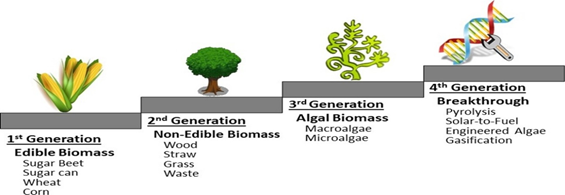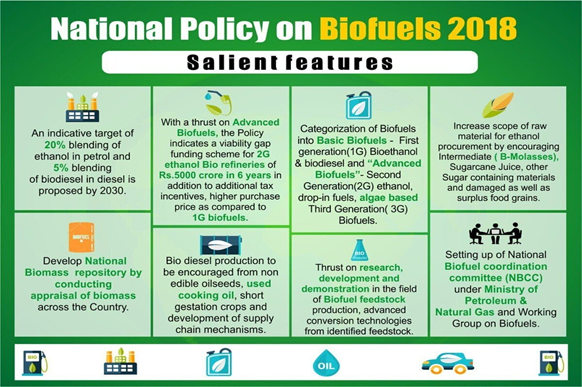

|
Overview
|
Context
- The Cabinet has approved amendments to the National Policy on Biofuels which expands the scope of raw material for ethanol blending to allow more feedstock for its production.
- It aims to advance the blending of ethanol in petrol target of 20 per cent and promote it under the Make in India program.
Background
- Biofuels have garnered global attention in recent times and it is imperative to keep up with the pace of developments in the field of biofuels. Biofuels are of strategic importance in India and augers well with the initiatives of the Government.
- India still relies heavily on crude oil imports for its domestic consumption requirements.
- However, fluctuating crude oil prices in the world market could affect the developing countries significantly.
- Biofuels program in India has been largely impacted due to the sustained and quantum non-availability of domestic feedstock for biofuel production which needs to be addressed.
- The National Biofuels Draft Policy came to light in 2007 and was launched by 2009.
- The existing National Policy on Biofuels came up in 2018.
What are Biofuels?
- A hydrocarbon fuel that is produced directly or indirectly from an organic matter is known as Biofuel.
- Biofuels are usually produced through a contemporary process (rather than from a slow geological process) from biomass. They are substitutes for the conventional forms of fuels – fossil fuels.
- The word biofuel is usually reserved for liquid or gaseous fuels, used for transportation.
How are they categorized?
- First Generation Biofuels: These are usually made from food sources containing sugar, starch, vegetable oil, or animal fats. The process utilizes conventional technology. Bioether
- These kinds of biofuels usually create an imbalance in the food economy as they tend to use agricultural crops, thus, leading to increased food prices and hunger.
- Second Generation Biofuels: these biofuels utilize inedible parts of the plant such as stems and husk to produce biofuel. These fuels usually require biochemical or thermochemical conversions during production. Biodiesel
- These biofuels do not affect the food economy however their production process is quite complicated.
- These fuels, however, emit fewer greenhouse gases in comparison to the first-generation biofuels.
- Third Generation Biofuels: These biofuels are produced using microorganisms such as algae. Micro-organisms like algae can be grown on land and water unsuitable for food production. This in return, reduces the strain on depleted water resources. Butanol
- Fourth Generation Biofuels: plants used for the production of the fourth-generation biofuel, are genetically modified to absorb and store higher amounts of carbon which can be harvested as biomass.
- This is then converted into biofuels using chemical conversion or thermochemical conversions.
- The fuel is pre-combusted and the carbon is captured. Then the carbon is geo-sequestered, meaning that the carbon is stored in depleted oil or gas fields or in unmineable coal seams.
- These fuels are mostly carbon neutral. Electrofuels
Advantages of Biofuels
- Availability: since biofuels only require biomass for their production, which is ubiquitous, biofuels are easy to produce.
- Reduction in waste: biofuels can also be produced using waste materials such as municipal sewage waste, inedible parts of the crops. This effectively aids in the reduction of waste.
- Reduce dependency on crude oil and non-renewable sources of fuels.
- Economic development: the production of biofuels can be a labour-intensive process thus resulting in the creation of jobs. This can provide a source of employment. It can aid in the development of rural areas when the second generation biofuel production units are set up there.
Disadvantages of Biofuels
- Low Efficiency: The efficiency of biofuels is much lesser compared to fossil fuels, as fossil fuels produce more energy on burning.
- Loss of biodiversity: the genetically modified crops used for the production of fourth-generation biofuels could result in a loss of biodiversity.
- Less availability of space: production of biofuels requires land, and in the case of second-generation biofuels, the crops used are mostly non-food crops, thus the production of biofuels requires a lot of space.
- Food shortage: The first generation biofuels make use of food sources and there is an imminent threat of facing food shortage if the production of biofuels is carried out extensively.
- Water usage: Massive quantities of water are required for proper irrigation of biofuel crops as well as to manufacture the fuel, which could strain local and regional water resources. This is, however, not the problem in case of the third generation biofuel.
About
National Biofuel Policy
- The policy is aimed at taking forward the indicative target of achieving 20% blending of biofuels with fossil-based fuels by 2030.
- The policy intends to ensure the adequate and sustained availability of domestic feedstock for biofuel production, increasing farmers’ income, import reduction, employment generation and waste to wealth creation.
- This policy clearly exhibits the Centre’s push towards strengthening the energy infrastructure of the country while promoting the agenda of sustainability.
Benefits
- It reduces the country’s dependence on imports.
- It promotes a cleaner environment: It results in a reduction in the burning of crops, as the agricultural waste/residue is converted to bioethanol.
- The re-use of cooking oil presents grave health hazards however it’s a potential feedstock for biodiesel.
- It also aids in Municipal Solid Waste (MSW) management. There are technologies available that can convert waste/plastic in the MSW to biofuels. One ton of such waste has the potential to provide around 20% reduction in fuels.
- The process of production of biofuels will aid in the creation of jobs.
- The conversion of surplus grains and agricultural biomass can help in price stabilization and thereby provide an additional source of income to the farmers.

Analysis
What are the proposed amendments?
- To allow more feedstocks for production of biofuels,
- To advance the ethanol blending target of 20% blending of ethanol in petrol to ESY 2025-26 from 2030,
- To promote the production of biofuels in the country, under the Make in India program, by units located in Special Economic Zones (SEZ)/ Export Oriented Units (EoUs),
- To add new members to the NBCC.
- To grant permission for export of biofuels in specific cases, and
- To delete/amend certain phrases in the Policy in line with decisions taken during the meetings of National Biofuel Coordination Committee
What is the need for amending the existing policy?
- Till 2018, only sugarcane was used to derive ethanol. Now, the government has extended the ambit of the scheme to include foodgrains like maize, bajra, fruit and vegetable waste, etc. to produce ethanol.
- This move helps farmers gain additional income by selling the extra produce and also broadens the base for ethanol production in the country.
- As Ethanol is one of the principal biofuels, which is naturally produced by the fermentation of sugars by yeasts or via petrochemical processes such as ethylene hydration.
- Starting with 5% blending, the government has set a target of 10% ethanol blending by 2022 and 20% blending (E20) by 2030.
Challenges associated
- Availability of sufficient feedstock on a sustainable basis: Current regulations in the country allow production of ethanol from sugarcane, sugar, molasses, maize and damaged foodgrains unfit for human consumption.
- Further, surplus rice with FCI is also allowed. Some states have demanded that rice procured by state governments be allowed for ethanol production.
- However, there is the issue of diverting foodgrains from human consumption to ethanol production when hunger and malnutrition are still problems faced by many in the country.
- Production Facilities: Ethanol production facilities have to be augmented if the goals of 20% blending by 2030 are to be achieved. Currently, ethanol production is largely confined to the sugar producing states.
- Sugar mills, which are the key domestic suppliers of bio-ethanol to OMCs, were able to supply only 57.6% of the total demand.
- The mills also do not have enough financial stability to invest in biofuel plants.
- Price uncertainty: The prices of both ethanol and sugarcane are fixed by the government leading to concerns among investors regarding the price of bioethanol.
- Availability of Ethanol: Ethanol is not equally available all over the country. This leads to an increase in transportation and logistics costs.
- Moreover, handling and storage of ethanol are also risky as it is a highly flammable liquid.
- Challenge for vehicle manufacturers: Vehicle manufacturers must work with vendors to develop automobile parts compatible with ethanol.
- They should work on engine optimisation for higher ethanol blends.
- Environmental clearances: Currently, ethanol production plants/distilleries fall under the “Red category” and require environmental clearance under the Air and Water Acts for new and expansion projects.
- This often takes a long time leading to delays.
Conclusion
In order to promote biofuels in the country, a National Policy on Biofuels was made by Ministry of New and Renewable Energy during the year 2009. Globally, biofuels have caught the attention in last decade and it is imperative to keep up with the pace of developments in the field of biofuels. Biofuels in India are of strategic importance as it augers well with the ongoing initiatives of the Government such as Make in India, Swachh Bharat Abhiyan, Skill Development and offers great opportunity to integrate with the ambitious targets of doubling of Farmers Income, Import Reduction, Employment Generation, Waste to Wealth Creation. Biofuels programme in India has been largely impacted due to the sustained and quantum non-availability of domestic feedstock for biofuel production which needs to be addressed.
|
Q1. Examine the potential and associated challenges of biofuels as a sustainable energy resource. Q2. “A recent report by the NITI Aayog highlighted the immense benefits India could accrue by 20% ethanol blending by 2025.” In this context, discuss the significance of ethanol blending for the environment and the Indian economy. What are the challenges in achieving 20% ethanol blending in India? |

